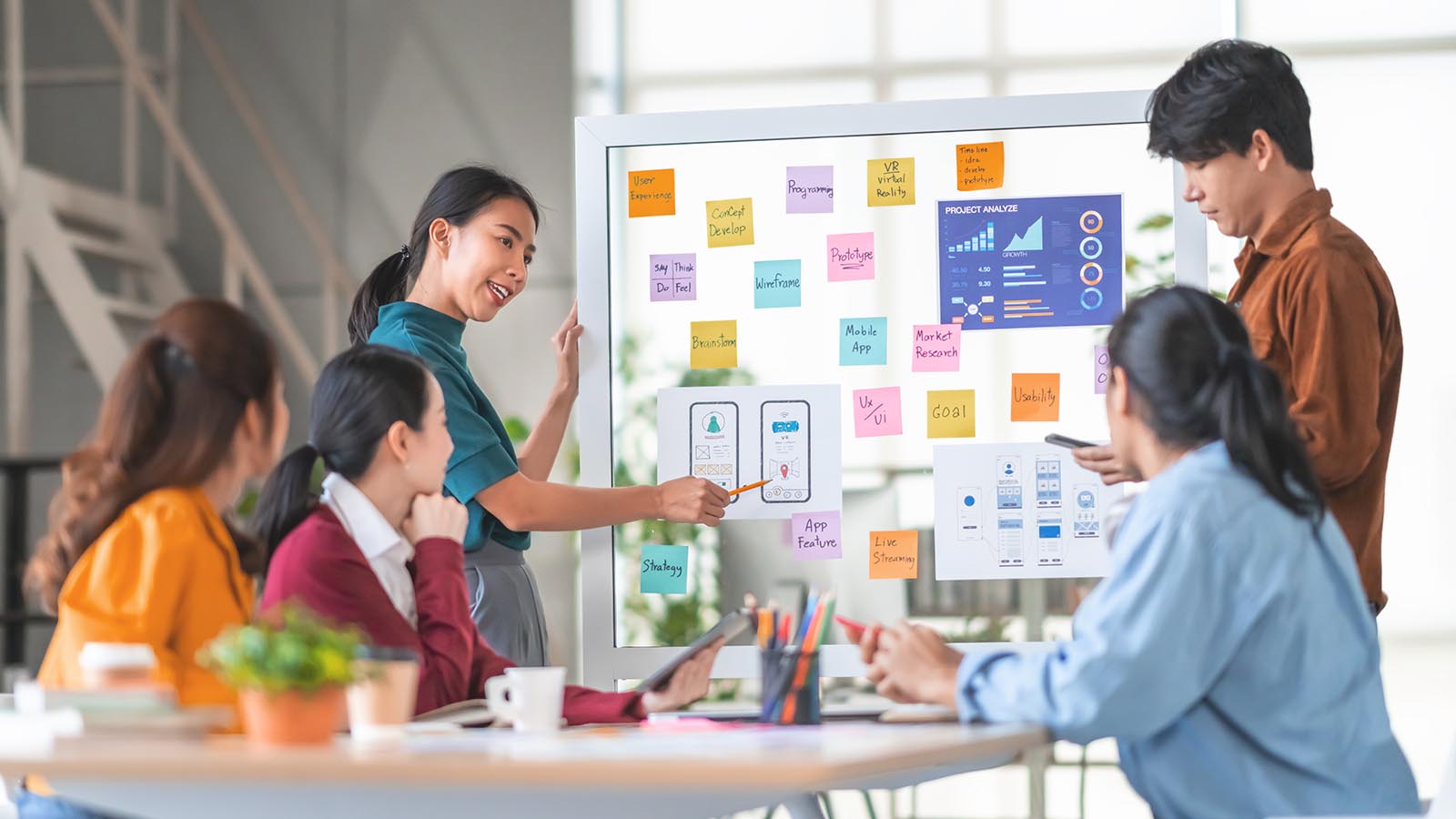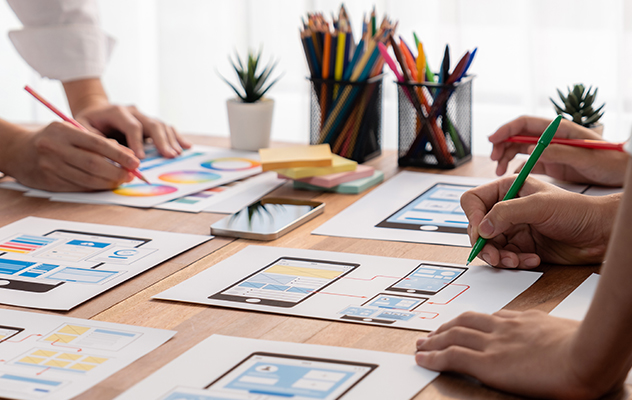
Jump To Section [hide]
What do you do when you need people to come together and be on the same page for a new concept at your organization?
Some back and forth via emails? Putting in requests for meetings where the conversations are driven by PowerPoint pitches? Having one discussion at a time, and that too only led by the extroverts or people with titles and power?
What about the value that the rest of the individuals at your organization can bring into these discussions? How do you cultivate an environment for brainstorming and a healthy exchange of ideas where every individual is a part of the conversation and contributing towards a purpose?
Contrary to the conventional ways of doing business that organizations have ingrained as common practice, there is a better solution. The latest research around creativity and innovation offers a much better way of aligning everyone on a shared goal: Design Thinking Workshops.
Design Thinking Workshops
Design Thinking Workshops help organizations combine the power of individual thinking with the cross-pollination of ideas and critical thinking. These workshops can truly accelerate innovation by transforming the way teams collaborate during design ideation to design and redesign products and services for their customers.
The design thinking workshop framework acts as a catalyst, bringing out the best ideas to light and speeding up innovation in the design thinking process.
Design thinking workshops are much more advanced than simply encouraging participants to talk about what needs to happen. Instead, they steer participants on HOW to do it.
Simply put, these workshops take design thinking ideation a step above and actually help you get things done – quickly and more effectively.
Let’s dive into what these different types of workshops are and how you can use them.
Types of Design Thinking Workshops
The type of design thinking workshop you need for your project is contingent on several factors:
- Why you need it to happen
- Who are the participants
- What is your end goal
In this article, we’ll look into 6 of the most important types of design thinking workshops:
1. Discovery Workshop
2. Ideation Workshop
3. Future Workshop
4. Design Sprint
5. Shape It Up
6. Remote Workshop
Depending on your situation, here’s a quick comparison of all the workshops before we jump into each one in detail:

This brings us to our next question: What do different kinds of design thinking workshops achieve, and which is the right one for you?
Let’s help you choose the best one for you in the next section by understanding each workshop in detail, its requirements, and outcomes.
Discovery Workshop

Best suited for the early stages of a project, a Discovery Workshop is a customized design thinking workshop designed to frame the problem from the end user’s perspective.
During this workshop, the focus is on the business goals, target user personas, their needs, journey maps of these users and opportunities for improvements in these journeys.
Who should attend
- Business & Sales Team Leads
- Product/Marketing Team Lead
- Solution Architects
- All other stakeholders critical to defining the problem
Why should we do it
Discovery
- Discovery workshops help uncover users’ problems, pain points, and needs through curated activities; developing user personas and mapping the current user journey helps identify and uncover any pain points along the way.
Context
- A deeper dive into the problem space provides context and a better understanding of the backend processes within the organization.
- Understanding the context more clearly also helps define the business success metrics.
Solving the RIGHT Problems
- This kind of design thinking workshop builds a shared vision and identifies the root causes of the problem.
- It also helps reframe the problems into opportunities to serve customers better.
- Through discovery workshops, you can prioritize the opportunities that are best aligned to the business and users’ goals.
- Defining ways to help validate ideas and concepts before committing time and budget to them saves resources.
- Quite often, these workshops help reframe the problem by shifting the focus from the solution to the problem. It is vital to spend sufficient time understanding the problem and gauge if that is the right problem to be solved. If we solve it, will it result in achieving the business goals?
How is it done
Discovery workshops are conducted through customized workshops and a set of activities that fit your needs and schedule.
What do we get out of it
- A common definition of project goals, success criteria, target users, and their journey of interaction with your products or services
- A short document detailing the workshop findings and possible next steps for engagement
- Often these workshops result in a defined scope for the project and can be followed up with a proposal for engagement
Designed for
- Small-medium size organizations
- Small groups of key decision-makers
- Developing new products and services
- Kickstarting and setting the scope for a large engagement
- Aligning stakeholders
- Creating alignment around the problem trying to be solved
Typical duration
A few hours to a full day (depending on the complexity of the problem)
Ideation Workshop

If you have already understood the problem and defined the success criteria of the project, it never hurts to have a second opinion on the approach to solve it. Ideation jams with customers can be a fun way to creatively solve the problems at hand.
An Ideation Workshop is a collaborative and rapid idea generation session intended to create as many ideas as possible to address the challenges at hand by empowering participants to think creatively.
Who should attend
- Stakeholders
- Business System Analysts
- Product Managers
- Designers
- Solution/Tech Architects
Why should we do it
Co-creation
- Ideation workshops help bring a diverse range of insights and minds to generate as many ideas as possible.
Fresh Ideas
- Inspiration is taken from solutions in the same problem space and adjacent areas to spark creativity.
- Subject matter experts and those from your organization are invited for TED-style keynotes, which bring everyone up to speed and provoke the thought process in that direction.
To explore ideas and make informed decisions
- Ideas are not only proposed by participants, but they are also evaluated by them in order to narrow down on the most impactful solutions.
How is it done
Ideation workshops comprise a disciplined framework that uses the best practices of ideation and innovation by providing time for individual brainstorming, building on top of ideas, connecting dots — then intelligently voting to shortlist the best ideas to move forward with.
What do we get out of it
- Understanding and exploration of the problem space
- Explore multiple solutions to address the challenge
- Established set of ideas that can be explored and refined to find solutions
- Set of experiments that can be conducted as next steps
Designed for
- Those looking for an outside-in view or second opinion on solving technology product, people, or process challenges
- Solving problems that demand creative and critical thinking
- Problems that are easy to lose focus on
- Establishing common ground amongst stakeholders
Typical duration
A few hours to a full day (depending on the complexity of the problem)
Future Workshops

Designed to explore the “art of the possible,” Future Workshops help align key stakeholders around the future vision of the company by taking a wide view of what’s already established in the market and what are the trends.
Working our way back, this vision is then translated into a high-level roadmap, for the present, for what’s next, and for the future.
Who should attend
- C-Level or Decision Makers
- Key Management
- Business and Sales leads (VPs)
Why should we do it
Uncover & Discover
- Assessing the current issues of customers and the business, future workshops aim to uncover problems, pain points and needs from both sides and create a shared vision of the future for your organization.
Alignment & Buy-In
- Such design thinking workshops help align all stakeholders’ understanding of the vision and garner buy-in.
Ideate, Evaluate & Envision
- They help generate solution ideas according to the timeline, evaluating them based on feasibility and user and business values for establishing a product roadmap.
How is it done
Collaboration is the vehicle that sparks the discussion on design ideation for user experience to the table through activities and diverse team effort.
What do we get out of it
- A shared vision of the future and what’s possible
- A detailed description of the short, mid, and long-term goals to get to the future vision
- A document detailing all the workshop findings and the next possible steps for exploration
Designed for
- Organizations/functional units interested in a long term roadmap and strategy for transforming business
- Exploring what major trends are in the market, what has worked so far in the industry and what hasn’t
- Determining what the ideal future looks like and what is the first steps to get there
- Planning to add new features or functionalities on an existing product(s)
Typical duration
2 to 4 hours
Design Sprint

This engagement takes you through the complete design cycle from problem defining and framing, solution brainstorming, solution defining and visualizing, solution viewing and visualizing of concept-solution in a rapid sprint spread over a week or two.
Who should attend
- Designers
- Developers
- Product Owner
- VP of Product
- Actual users (if possible)
Why should we do it
Day 1: To Understand
- Map out the problem space and create a shared vision.
Day 2: To Ideate/sketch
- Generate a broad range of ideas and narrow down on possible solutions.
Day 3: To Decide
- Determine what to prototype to answer sprint questions.
Day 4: To Prototype
- Build one to two prototypes required to validate the idea.
Day 5: To Validate or deliver the finalized solution (e.g. artifacts) and relevant documents
- Test with five target users or review with the client to get valuable feedback.
- Deliver the finalized solutions, including a concept brief, prototype, and a process document.
Design Sprints are aimed at understanding the context, validating ideas and releasing an MVP quickly in the market. These workshops also cater to helping everyone on the team understand the value other team members can bring as well as the struggles they face.
How is it done
We take you through joint daily sessions (outlined above) to move from the problem to the solution stage; providing direction, review, feedback, and ideation along the way
What do we get out of it
- Abstract to Concrete: Turning abstract concepts and ideas into tangible prototypes (digital or physical experience) with user feedback
- Business goals and objectives
- Personas & Journeys: User personas and journeys documenting pain points, challenges, and opportunities for improvement
- Wireframes and mockups for digital experience
- Development/Implementation estimates with a +/- 50% confidence
Designed for
- Startups
- Small business or a smaller team
- Client or business who a relatively simple problem
- Client or business who has a clear direction for the solution
- Client or business that needs to test and validate ideas for MVP quickly
Typical duration
1 to 3-week engagement
Shape It Up

Shape It Up is a complete end-to-end engagement that takes you through the entire design cycle, from discovery to user experience design, technical solution design and hand-over to development.
This engagement allows us to work with product owners and business heads throughout the entire cycle leading you along the way and ensuring any outcome is aligned with your business goals and meets user needs.
Who should attend
Everyone who is related to the project, affected by issues or outcomes, and diverse teams are encouraged to participate:
- Designers
- Developers
- Business Analysts
- C-level executives
- Management,
- Product management
- Sales, customer services
- Even real users
Why should we do it
- This is the most comprehensive engagement and is highly effective in producing the best solutions based on defining the right problem, understanding the customer and business needs, as well as other realistic factors that need to be considered before making a huge investment.
- Understanding that stakeholders at your organization manage multiple projects at any given time and it may not be feasible to bring everyone together for a dedicated design sprint in a short time frame, this engagement adopts a mixed model approach. It consists of a few workshops and deep-dive sessions with relevant stakeholders. This vision is then translated into a solution that is reasonably “shaped up,” and development teams can be engaged for implementation and rapid rollout.
How is it done
Shape It Up workshops and regular joint working sessions to assess, gather, and frame the right problem and solution collaboratively as well as deliver the concept, MVP and a product roadmap along with a technology solution documentation.
What do we get out of it
- Project documentation containing the process, findings, research, concept designs, and technical development
- Personas, experience and journey maps, mockups and interactive prototypes
- Solution system architecture, a product roadmap, other technical documents that are required for product development and management
Designed for
- Business at any scale
- A complex solution that requires customer interfaces, middleware or backend systems integrations
- B2B, B2C, B2B2C solutions or products
Typical duration
1 to 2 months (depending on the complexity of the problem)
Remote Workshops

Remote workshops are meant for dispersed teams located in remote locations and time zones. For stakeholders and team members in such situations, there are several frameworks for remote collaboration that can be used. These help facilitate remote design workshops using virtual tools that provide a great deal of value, but at the same time are not bound by physical or geographical limitations.
You’ll find a deeper understanding of remote workshops in this article, which will provide you with all you need to know to conduct them, what virtual tools and processes you’ll need, and how to make the most out of remote workshops while working from home.
Takeaway
While design thinking workshops can prove to be largely impactful for alignment, they’re not the end-all solution.
The real value from design thinking workshops is in their implementation and facilitation. Without applying the frameworks of these design thinking workshops in their true sense, you would simply end up having just another “meeting” — wasting time, energy, and resources.
To successfully experience a workshop, there needs to be a willingness to participate, the effort to prepare, and the dedication to follow through with the outcomes.
The design thinking workshops we covered in this article are designed to take you from the abstract to the concrete. Within a few hours, instead of taking weeks to materialize ideas in traditional ways of working, these workshops will help facilitate your team to ideate design thinking and draw focus on the present, bringing to light important information, ideas, and actionable next steps. This is the “concrete” foundation that will serve as the stepping stone to move out of the problem and into the solution space.
FAQs
What is the design process in UX?
The process of design ideation for user experience comprises multiple, distinct steps that include user research, testing, validation, implementation, etc.
What is human centered design thinking?
Human-centered design thinking accounts for the humanistic approach to design via a deep sense of empathy for the target users. It uses the everyday emotions, thoughts, and behaviours of the people using the design as the North Star to creatively approach situations and find the best solutions to the problem at hand.
What are the steps of the design thinking process?
The design thinking process is an end-to-end journey that covers every step from ideation to implementation. It covers problem identification, UX research, design ideation, solutioning, prototyping, testing, and improving iteratively.
What does design thinking work for?
Design thinking is used to identify and solve problems creatively and iteratively. The approach prioritizes the end users’ need, above everything else, by observing their interactions, everyday behaviours, thoughts, and emotions to truly empathize and innovate for the best solutions.



